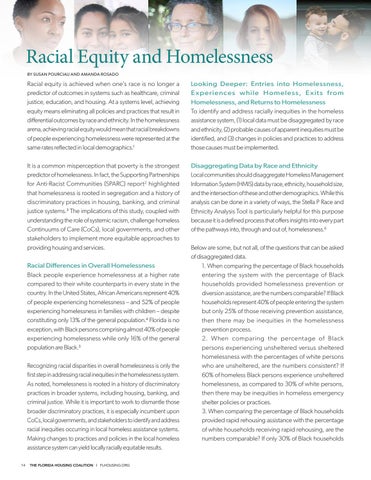Racial Equity and Homelessness BY SUSAN POURCIAU AND AMANDA ROSADO
Racial equity is achieved when one’s race is no longer a predictor of outcomes in systems such as healthcare, criminal justice, education, and housing. At a systems level, achieving equity means eliminating all policies and practices that result in differential outcomes by race and ethnicity. In the homelessness arena, achieving racial equity would mean that racial breakdowns of people experiencing homelessness were represented at the same rates reflected in local demographics.1
Looking Deeper: Entries into Homelessness, E xperiences while Homeless, E xit s from Homelessness, and Returns to Homelessness To identify and address racially inequities in the homeless assistance system, (1) local data must be disaggregated by race and ethnicity, (2) probable causes of apparent inequities must be identified, and (3) changes in policies and practices to address those causes must be implemented.
It is a common misperception that poverty is the strongest predictor of homelessness. In fact, the Supporting Partnerships for Anti-Racist Communities (SPARC) report2 highlighted that homelessness is rooted in segregation and a history of discriminatory practices in housing, banking, and criminal justice systems.3 The implications of this study, coupled with understanding the role of systemic racism, challenge homeless Continuums of Care (CoCs), local governments, and other stakeholders to implement more equitable approaches to providing housing and services.
Disaggregating Data by Race and Ethnicity Local communities should disaggregate Homeless Management Information System (HMIS) data by race, ethnicity, household size, and the intersection of these and other demographics. While this analysis can be done in a variety of ways, the Stella P Race and Ethnicity Analysis Tool is particularly helpful for this purpose because it is a defined process that offers insights into every part of the pathways into, through and out of, homelessness.6
Racial Differences in Overall Homelessness Black people experience homelessness at a higher rate compared to their white counterparts in every state in the country. In the United States, African Americans represent 40% of people experiencing homelessness – and 52% of people experiencing homelessness in families with children – despite constituting only 13% of the general population.4 Florida is no exception, with Black persons comprising almost 40% of people experiencing homelessness while only 16% of the general population are Black.5 Recognizing racial disparities in overall homelessness is only the first step in addressing racial inequities in the homelessness system. As noted, homelessness is rooted in a history of discriminatory practices in broader systems, including housing, banking, and criminal justice. While it is important to work to dismantle those broader discriminatory practices, it is especially incumbent upon CoCs, local governments, and stakeholders to identify and address racial inequities occurring in local homeless assistance systems. Making changes to practices and policies in the local homeless assistance system can yield locally racially equitable results. 14 THE FLORIDA HOUSING COALITION | FLHOUSING.ORG
Below are some, but not all, of the questions that can be asked of disaggregated data. 1. When comparing the percentage of Black households entering the system with the percentage of Black households provided homelessness prevention or diversion assistance, are the numbers comparable? If Black households represent 40% of people entering the system but only 25% of those receiving prevention assistance, then there may be inequities in the homelessness prevention process. 2. When comparing the percentage of Black persons experiencing unsheltered versus sheltered homelessness with the percentages of white persons who are unsheltered, are the numbers consistent? If 60% of homeless Black persons experience unsheltered homelessness, as compared to 30% of white persons, then there may be inequities in homeless emergency shelter policies or practices. 3. When comparing the percentage of Black households provided rapid rehousing assistance with the percentage of white households receiving rapid rehousing, are the numbers comparable? If only 30% of Black households









